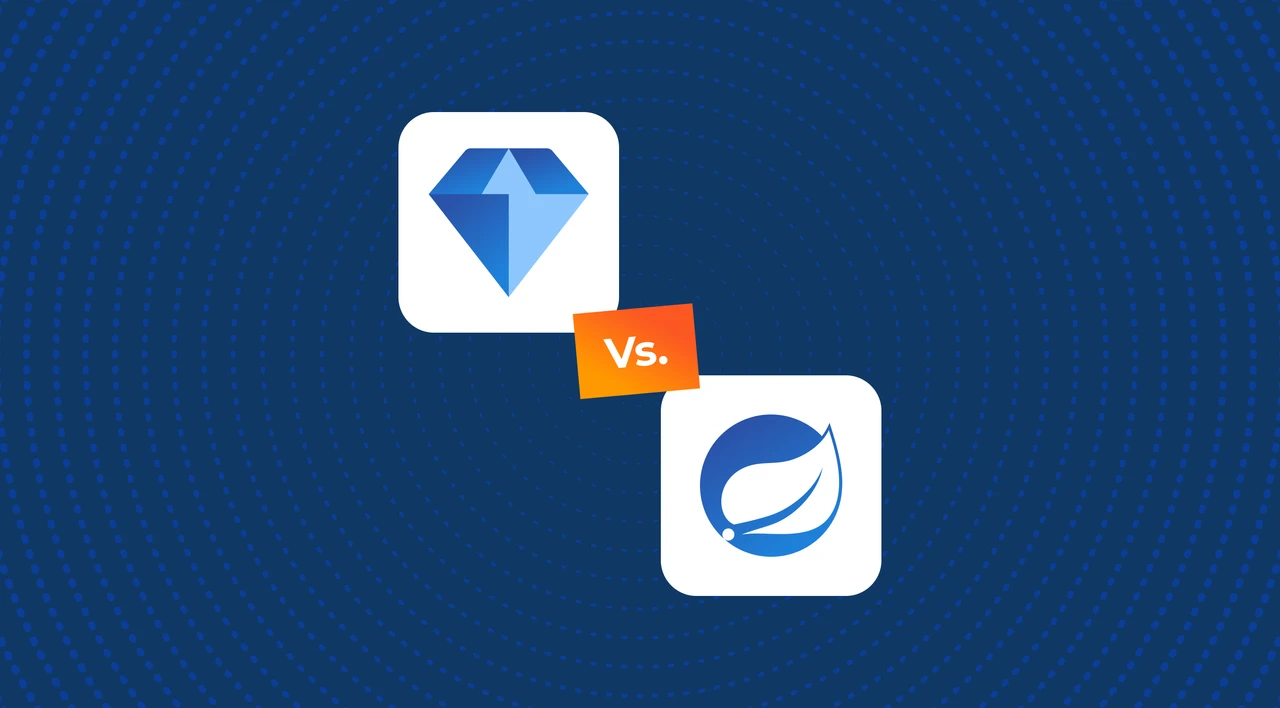SHARE
Ruby on Rails vs. Spring Boot: Which is Better in 2026?

Contents
Contents
Introduction
When we mention back-end web frameworks, several options come to mind. However, Ruby on Rails and Spring Boot are top choices for many developers and it’s not hard to see why. These two software frameworks have various functionalities that aid in streamlining back-end development. They provide a platform for building server-side applications, database access, and interactions, and they handle routing effectively.
However, the Ruby on Rails and Spring Boot frameworks have different architectural patterns and are written in different programming languages. This piece will, therefore, compare these frameworks and help you decide which one is better in 2024.

Introduction to Ruby on Rails
Ruby on Rails is a prominent, comprehensive web application framework written in Ruby, a simple and object-oriented language created by Yukihiro Matsumoto in the 1990s. This framework follows the Model-View-Controller architectural pattern, which favors convention over configuration (CoC) to enhance productivity by minimizing configuration.
The objective of the MVC pattern is to allow each Rails component – the model, view, and action controller to exist independently of the other and manage its responsibilities distinctively. This means changes in the Model don’t affect the others. As a result, developers can work on various areas separately. Consequently, it becomes more convenient to maintain and organize a codebase. Additionally, it becomes easier to start developing a scalable application using a structured approach.
Apart from following the principles of convention over configuration to prevent repetitive tasks, Rails has features like ActiveRecord. Which is an object-relational mapping library that reduces the complexity of database operations by translating database tables into Ruby objects. This allows developers to perform database tasks with Ruby code.
Another feature of this framework is Scaffolding. It is a potent code generation tool that automatically forms a simple set of files based on the three Rails components for a user. Users can create, read, update, and delete files immediately with this unique configuration.
Rails have other features, such as built-in support for routing and handling various requests, session handling, and security. It also has a robust network of gems, templates, and plugins, which offers extra functionality. This open-source framework is becoming popular for developing back-end web apps due to its simplicity and efficiency. It has been used to build web apps like Twitter and Airbnb.

Introduction to Spring Boot
Spring Boot is a Java framework that leverages the fundamental features of Spring to simplify the development of standalone applications. Spring is an open-source network with a simple configuration model for building Java-dependent applications.
Some of the key features of this Java framework include dependency injection (DI) and aspect-oriented programming (AOP). These Spring Boot features address all the unconventional aspects of web application development. Dependency injection manages the instant responses and configuration of web components, allowing you to test and maintain the application. On the other hand, AOP helps you to fulfill some specific functions by separating concerns, such as security and logging from the core business protocols, enabling better organization.
Spring Boot leverages this underlying Spring framework and its core features to develop Spring-based apps. However, it discards a significant amount of code usually required to build an application, allowing the developer to pay more attention to writing business logic.
One of the core capabilities of Spring Boot is its automatic configuration ability. It sets up an application according to the dependencies available, significantly reducing the time to manually configure the application. Plus, Spring Boot also follows the convention over configuration principle, which uses sensible default unless when overridden.
Another strength of Spring Boot is its embedded server that allows you to run a standalone executable JAR file application. In addition, it has a potent command-line interface for performing instant actions, such as health checks. Many Java developers love Spring Boot for its ease of use, efficiency, and ability to create scalable web applications.
Advantages of Ruby on Rails over Spring Boot
Rails exhibit certain characteristics that give it an edge in some areas over Spring Boot. Below are some of the advantages:
- Rails has better developer productivity than Spring Boot. Because it follows the convention over the configuration principle, it minimizes code requirements. This enhances productivity and fosters faster app development.
- The framework creates faster and more functional prototypes than Spring Boot due to its simple code generation.
- It abides by a set of conventions for database management and organizing files, promoting consistency and minimizing the need for extensive configuration.
- It also encourages rapid application development, thanks to its code generation features like scaffolding and CoC.
Advantages of Spring Boot over Ruby on Rails
Spring Boot has advantages over Rails in language versatility, scalability, adoption, integration, and architecture. More advantages include:
- The Spring Boot framework is built on Java, a widely used programming language in web application development. Java is vast and offers more options than the Ruby programming language.
- Spring Boot is more robust, scalable, and better suited to production-grade applications. This is due to the Java language, which helps to check for errors at compile time, minimizing runtime problems.
- Since Spring Boot is built on the Java ecosystem, it can integrate with other frameworks. It also gives users more developer options.
- Spring Boot constitutes the larger Spring network, which provides vast tools for enterprise application development.
- Spring Boot is more adopted in the enterprise world than Rails due to its high configuration and Java language.
- Spring Boot has a more mature testing framework than Rails with tools, such as JUnit, for testing various components of an application to ensure quality.
Ruby on Rails vs. Spring Boot Comparison
The comparison between Rails and Spring Boot is always controversial. We compare both based on the following factors.
Programming Language
Spring Boot is built on Java, while Rails is built on Ruby. However, Java is more versatile and used for developing enterprise applications because of its extensive and mature ecosystem.
Learning Curve
The learning curve for Rails and Spring Boot frameworks depends on the individual’s prior experience and acquaintance with the programming language. To learn Rails, you’ll have to learn the Ruby language. This includes understanding the object-oriented syntax and semantics, the conventions, routing, etc. If you’re starting, you can fully grasp the Ruby language with the extensive tutorials and resources provided by its community.
On the other hand, learning Spring Boot demands a solid understanding of Java, its basic concepts, configuration, and the entire Spring framework. You have to study several modules and resources to learn the Java Spring framework and the broader ecosystem to write code and create apps. This may take a while.
Conclusively, the learning curve for Rails is moderate and more straightforward than Spring Boot due to its emphasis on convention and simplicity.
Stability
Rails and the Spring Boot framework are known for their stability and long-term support. Rails provide support for stable versions periodically, maintaining productivity and ensuring bug fixes. Spring Boot also ensures backward compatibility for stable versions, although newer than Rails.
Community Support
The community support for both Rails and Spring Boot differs. Ruby on Rails has a more active developer community and support than Spring Boot. It is because the former has an abounding ecosystem of gems and plugins for different functionalities. This wider range of resources makes Ruby on Rails better-supported community-wise than Spring Boot.
Popularity
Both frameworks are popular, although Rails is much older (introduced in 2004). Spring Boot has gained massive popularity since its emergence because of its wider industry use. It has an extensive ecosystem that offers a wide range of configuration options and flexibility for enterprise developers.
Ruby on Rails vs. Spring Boot: Which is Better?
Rails and Spring Boot frameworks are excellent for building web applications, but their use depends on what you want. Generally, Ruby on Rails may be advantageous in some areas, but Spring Boot is preferred for developing complex and standalone applications. Ruby on Rails lacks extensive configuration and the flexibility for more customization because of its convention-based approach. Even with its abundance of plugins and gems, Ruby on Rails can only create small to medium-scale applications.
Summary
The Rails Vs. Spring Boot comparison has generated diverse views over the years. It’s not a surprise, given they are undoubtedly some of the most popular frameworks for web application development. While they have advantages, your choice will ultimately depend on the ecosystem that aligns with your requirements or suits your needs.
Frequently Asked Questions
What alternatives are there to Ruby on Rails and Spring Boot?
Several alternatives to Rails and Spring Boot include; Vue.js and React, Laravel, Flask, Django, ASP.NET Core, and Express.js. These frameworks are written in other languages and can be used to create a web app.
How do you learn the Ruby on Rails framework?
You can learn Rails by studying the resources and comprehensive documentation provided by the community. You can also learn on YouTube and through some courses on Udemy.
What is a full-stack framework?
A full-stack framework is a software network that provides development tools and functionalities for building front-end and back-end web apps and integrating databases. Rails and Spring Boot are back-end networks with web services.
Where can I find a Java Spring Boot tutorial?
You can find a Java Spring Boot tutorial on the framework’s official website, YouTube, and Udemy.
How does Ruby on Rails enable rapid development?
Ruby on Rails development abides by the Convention over Configuration principle, which aims to simplify tasks and focus on code generation. The scaffolding feature creates a basic set of codes and views to create, read, update, and delete operations, helping developers to accelerate the building of applications.
Expert Ruby on Rails Development Services
Flatirons Development is a top-rated Ruby on Rails service provider.
Get the CEO's Take
Handpicked tech insights and trends from our CEO.
Expert Ruby on Rails Development Services
Flatirons Development is a top-rated Ruby on Rails service provider.
Get the CEO's Take
Handpicked tech insights and trends from our CEO.

Enterprise Computing: Transforming Business Operations
Flatirons
Oct 09, 2025
Explore the Top Embedded Systems Examples of Today
Flatirons
Oct 04, 2025
Best Manual Testing Tools to Boost Your Software Quality
Flatirons
Sep 28, 2025
Digital Product Development: Enhance Your Business Offerings
Flatirons
Sep 12, 2025
React SEO: Optimize Your React Apps for Search Engines
Flatirons
Sep 07, 2025
Will Software Engineers Be Replaced by AI?
Flatirons
Aug 31, 2025